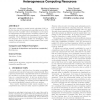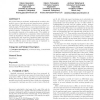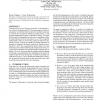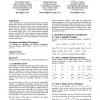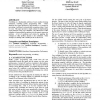103
click to vote
GECCO
2005
Springer
15 years 6 months ago
2005
Springer
This paper evaluates a parallel genetic algorithm (GA) on the line topology of heterogeneous computing resources. Evolution process of parallel GAs is investigated on two types of...
96
Voted
GECCO
2005
Springer
15 years 6 months ago
2005
Springer
In this study, we introduce two improved assessment metrics of multiobjective optimizers, Nondominated Ratio and Spacing Distribution, and analyze their rationality and validity. ...
85
Voted
GECCO
2005
Springer
15 years 6 months ago
2005
Springer
Recurrent neural networks are theoretically capable of learning complex temporal sequences, but training them through gradient-descent is too slow and unstable for practical use i...
100
click to vote
GECCO
2005
Springer
15 years 6 months ago
2005
Springer
We present discrete stochastic mathematical models for the growth curves of synchronous and asynchronous evolutionary algorithms with populations structured according to a random ...
94
Voted
GECCO
2005
Springer
15 years 6 months ago
2005
Springer
Code bloat, the excessive increase of code size, is an important issue in Genetic Programming (GP). This paper proposes a theoretical analysis of code bloat in the framework of sy...
79
Voted
GECCO
2005
Springer
15 years 6 months ago
2005
Springer
Various algorithms have been developed and applied to structural optimization, in which cross-sectional areas of structure members are assumed to be continuous. In most cases of p...
70
Voted
GECCO
2005
Springer
15 years 6 months ago
2005
Springer
This paper examines a real-world application of genetic algorithms – solving the United States Navy’s Sailor Assignment Problem (SAP). The SAP is a complex assignment problem ...
99
Voted
GECCO
2005
Springer
15 years 6 months ago
2005
Springer
Relative fitness, or “evaluation by tests” is one of the building blocks of coevolution: the only fitness information available is a comparison with other individuals in a p...
GECCO
2005
Springer
15 years 6 months ago
2005
Springer
Multimodal optimization algorithms inspired by the immune system are generally characterized by a dynamic control of the population size and by diversity maintenance along the sea...
87
Voted
GECCO
2005
Springer
15 years 6 months ago
2005
Springer
Overfitting is a fundamental problem of most machine learning techniques, including genetic programming (GP). Canary functions have been introduced in the literature as a concept ...
